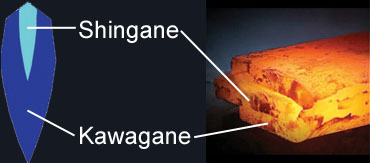By lyuesword | 09 October 2021 | 1 Comments
SHINGANE VS KAWAGANE STEEL: WHAT'S THE DIFFERENCE?
Traditional Japanese swords are known for their superior quality and attention to detail. During the region's feudal period, Japanese bladesmiths discovered that using specific combinations of metals allowed for stronger, more versatile swords. And while different bladesmiths used their own forging techniques, most used two different metals to forge swords: shingane and kawagane steel. So, what's the difference between these two types of steel?
Shingane Steel
Shingane is a type of steel used in the production of traditional Japanese swords. It features a high concentration of iron and a low concentration of carbon. As a result, it's relatively soft and ductile. Japanese bladesmiths typically didn't use shingane steel to produce the exterior of their swords' blades, however. Because of its soft and ductile properties, shingane was used primarily to make the core of a blade. Softness doesn't matter as much for the core of a sword's blade. In fact, it's actually beneficial, as it allows the sword to bend and flex under pressure without breaking.
In Japan's early bladesmithing days, hard steel was used to produce swords. Unfortunately, this resulted in countless swords breaking upon impact. Bladesmiths then recognized the need for softer swords, so they began to experiment with different types of metal, eventually leading to the development of shingane steel.
Kawagane Steel
In addition to shingane, bladesmiths in feudal Japan also used kawagane steel to produce blades for swords and knives. Kawagane, however, features different properties than its shingane counterpart, the most notable being a high concentration of carbon. Kawagane steel contains significantly more carbon than shingane. Japanese bladesmiths found that high-carbon steel such as this was stronger and more resistant to damage than low-carbon steel. As a result, they typically used kawagane steel to produce the exterior "jacket" of blades.
Using Shingane and Kawagane Steel Together
Rather than using a single type of metal, Japanese bladesmiths have traditionally used two or more metals to produce swords. Shingane and kawagane is the most common combination used to produce high-quality traditional Japanese swords like the katana and wakizashi. Bladesmiths use the softer shingane steel to produce the blade's interior core, while the harder kawagane steel is used to produce the blade's exterior jacket. The synergistic combination of these two metals results in a sword with a strong, sharp blade that can still flex without breaking.
Want a unique sword? Feel free to contact us:
Email: lyuesword@hotmail.com
Website: www.lyuesword.com
Custom Sword Page: www.lyuesword.com/Custom-Sword/customization-options/Create-Your-Own-Swords
Shingane Steel
Shingane is a type of steel used in the production of traditional Japanese swords. It features a high concentration of iron and a low concentration of carbon. As a result, it's relatively soft and ductile. Japanese bladesmiths typically didn't use shingane steel to produce the exterior of their swords' blades, however. Because of its soft and ductile properties, shingane was used primarily to make the core of a blade. Softness doesn't matter as much for the core of a sword's blade. In fact, it's actually beneficial, as it allows the sword to bend and flex under pressure without breaking.
In Japan's early bladesmithing days, hard steel was used to produce swords. Unfortunately, this resulted in countless swords breaking upon impact. Bladesmiths then recognized the need for softer swords, so they began to experiment with different types of metal, eventually leading to the development of shingane steel.
Kawagane Steel
In addition to shingane, bladesmiths in feudal Japan also used kawagane steel to produce blades for swords and knives. Kawagane, however, features different properties than its shingane counterpart, the most notable being a high concentration of carbon. Kawagane steel contains significantly more carbon than shingane. Japanese bladesmiths found that high-carbon steel such as this was stronger and more resistant to damage than low-carbon steel. As a result, they typically used kawagane steel to produce the exterior "jacket" of blades.
Using Shingane and Kawagane Steel Together
Rather than using a single type of metal, Japanese bladesmiths have traditionally used two or more metals to produce swords. Shingane and kawagane is the most common combination used to produce high-quality traditional Japanese swords like the katana and wakizashi. Bladesmiths use the softer shingane steel to produce the blade's interior core, while the harder kawagane steel is used to produce the blade's exterior jacket. The synergistic combination of these two metals results in a sword with a strong, sharp blade that can still flex without breaking.

Want a unique sword? Feel free to contact us:
Email: lyuesword@hotmail.com
Website: www.lyuesword.com
Custom Sword Page: www.lyuesword.com/Custom-Sword/customization-options/Create-Your-Own-Swords
Recently Reviews
Read MoreLeave a Reply
Your email address will not be published.Required fields are marked. *